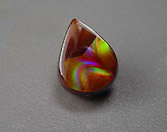

My appreciation for fire agate has taken time to reach its current very high level. Most of the pieces I saw early-on were poorly fashioned and of low quality, and frankly, I wasn't impressed. Since beginning my serious study of gems, however; I've had the opportunity to see some outstanding specimens and as a result, my enthusiasm has increased dramatically.
Fire agate is a brown, microcrystalline quartz (chalcedony) which has a botryoidal (grape-like) growth form, and which contains layers of plate-like crystals of iron oxide (limonite) in various planes within it. The iridescent colors of red, gold, green and rarely, blue-violet, result from interference between diffracted light rays traveling through and reflecting off of these thin layers. (We see the same effect when looking at the rainbow colors at the surface of an oily puddle of water; or in the "orient" created by the layers of nacre on the surface of pearl.) Usually, fire agate pockets occur within specimens of colorless, white or light grey chalcedony.
Fire agate is found only in the US Southwest and Mexico and wasn't brought into commerce until after World War II. This, combined with the fact that it's one of the most difficult opaque materials to cut properly, keeps it scarce and mostly unknown to the general public.
In order to best reveal the colors, the overlying layers of chalcedony must be very carefully removed from the botryoidal surface creating a freeform shape with a carved upper surface. Just a tiny bit too much material removed kills the iridescence and too much left on dulls it. Such painstaking treatment requires substantially more time per piece by the lapidary, and tends to elevate cost. This type of fashioning also leads to a lack of calibrated pieces and has prevented the use of this gem in mass produced jewelry items.
Good fire agates are as impressive in their color display as fine black opal, but far less expensive. Additionally, fire agate is as hard and durable as any aggregate quartz making it wonderful for jewelry uses, including rings. The colors and form are rich and dramatic and generally appeal strongly to men (although I can personally attest to its appeal to women!)




The most desirable pieces show color over the entire surface with no "dead" spots. Red color is generally the most highly valued, but the few pieces with some lavender-blue are also highly sought after. The pattern of colors can be a value factor too. Similar to what is seen in opal, the colors can be tiny dots "pin fire", large blotches "harlequin" or, rarely, have a distinctive pattern such as circles or stripes. Well cut, carved and polished pieces with an attractive freeform outline are more valuable than those produced with a smooth crown and a standard cabochon shape.